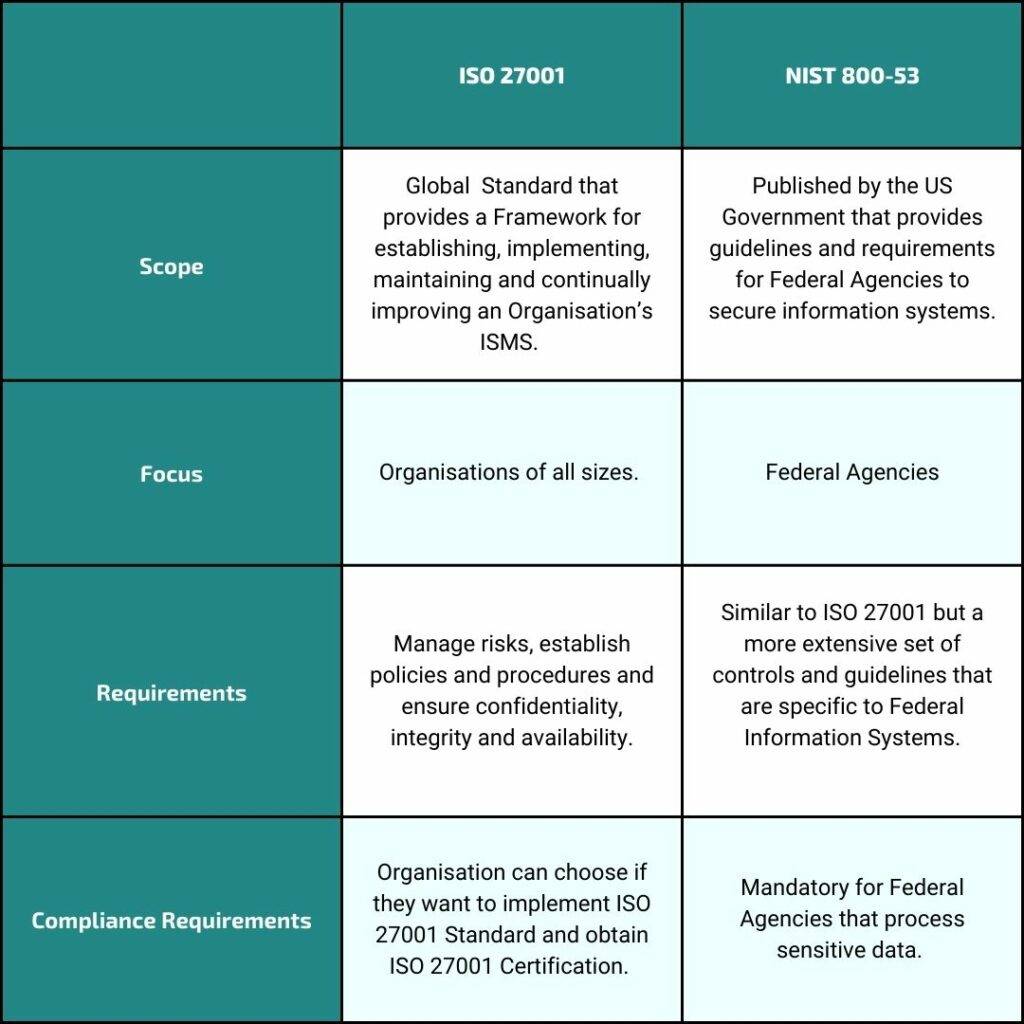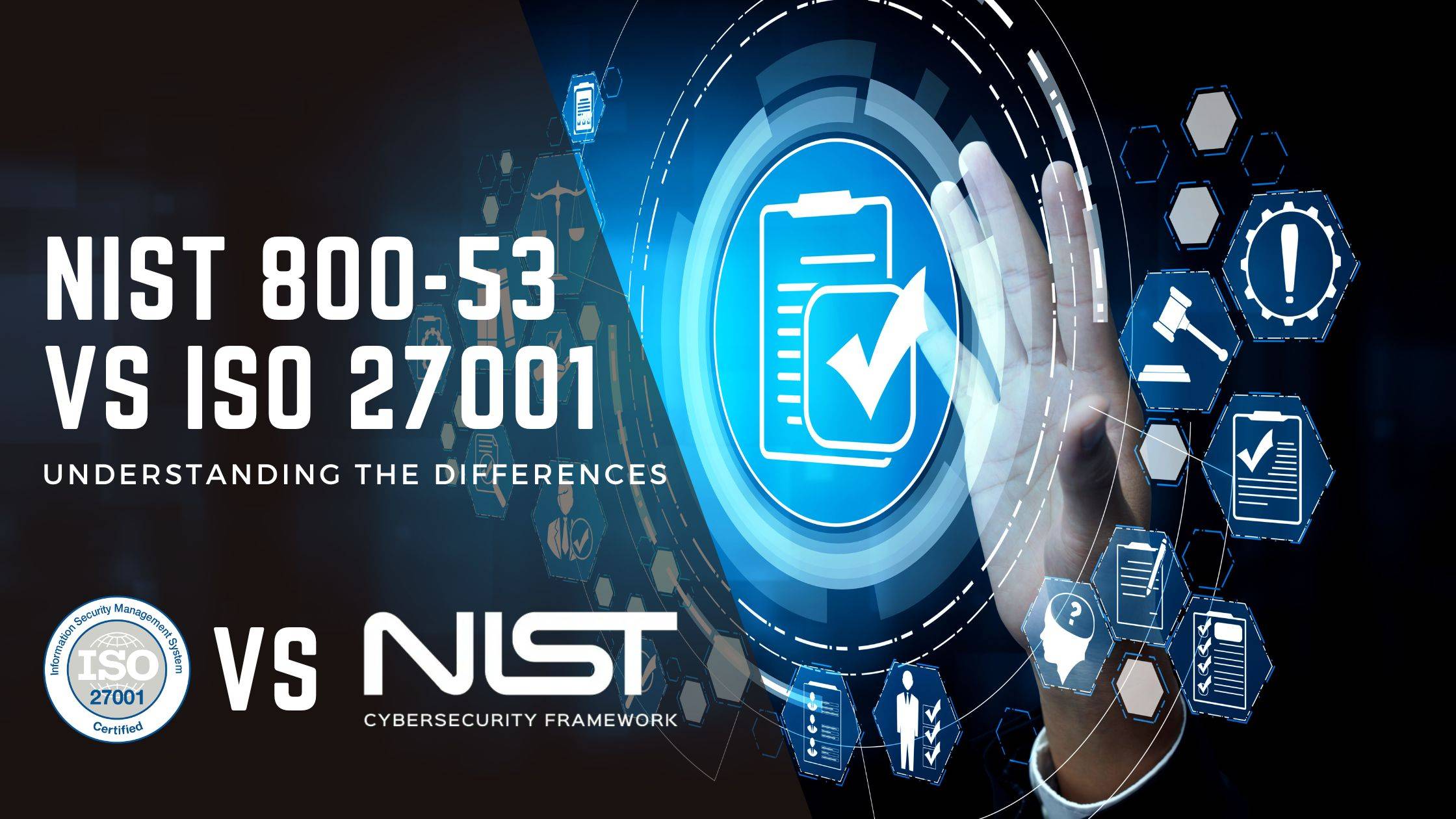Table of Contents
ToggleIntroduction
ISO 27001 and NIST 800-53 are two different sets of Security Standards that are widely used in the field of information security. They are used by organisations to protect their sensitive information. Both ISO 27001 and NIST 800-53 are important Standards in the field of information security but differ in their scope and level of details. Organisations should carefully consider their specific needs and requirements when choosing which Standard to implement.
ISO 27001
ISO 27001 is a set of international standards developed by the International Organisation for Standardisation [ISO] that provides a framework for managing and protecting information using a risk management approach. It is a comprehensive set of controls and best practices that cover a broad range of security areas such as physical security, network security, access control and business continuity.
Key requirements of ISO 27001
- Risk management: ISO 27001 requires organisations to identify and evaluate the risks pertaining to the Organisation’s information security practices and to implement appropriate controls to manage those risks.
- Asset management: Organisations must identify and manage their information assets including hardware, software and data. This includes understanding the value of each Asset and risks associated with it.
- Continuous improvement: ISO 27001 requires organisations to continuously monitor and improve their Information Security Management System [ISMS] to ensure its ongoing effectiveness.
- Incident Management: Organisations must have procedures in place to detect, report and respond to information security incidents.
Benefits of ISO 27001 certification
- Increased customer trust: ISO 27001 certification demonstrates to customers that an organisation has implemented a comprehensive Information Security Management System that meets International Standards. This can help to build trust and confidence in an Organisation and its services.
- Compliance with legal and regulatory requirements: ISO 27001 Certification can help organisations to demonstrate Compliance with relevant legal and regulatory requirements such as data protection and privacy laws.
- Reduced risks: By implementing the requirements of ISO 27001, organisations can identify and manage risks to their information security which can reduce the likelihood of security incidents.
- Better internal process: ISO 27001 requires organisations to establish and maintain an Information Security Management System which can lead to better internal processes and procedures.
- Improve stakeholder confidence: ISO 27001 Certification can improve stakeholder confidence in an Organisation’s ability to protect sensitive information which can be especially important for organisations that handle sensitive information or data.
NIST 800-53
NIST 800-53 is a set of Security Controls developed by the National Institute of Standards and Technology [NIST] to provide a comprehensive catalogue of security and privacy controls for Federal Information Systems and Organisations. It is a Framework that provides detailed guidance on how to implement and manage security controls and provides organisations with a risk-based approach to information security.
Standard’s requirements are organised into 18 control families which include access control, audit and accountability, identification and authentication, incident response, system and communication protection.
Specific requirements of NIST 800-53
- Access control: The Standard requires organisations to implement access control to prevent unauthorised access to information systems and data. This includes requirements for authentication, authorisation and accountability.
- Audit and accountability: NIST 800-53 requires organisations to implement audit and accountability controls to monitor and track access to information systems and data. This includes requirements for audit logs, audit trail analysis and incident response.
- System and communication protection: The Standard requires organisations to implement controls to protect information systems and data from unauthorised access and other threats.
- Incident Response: It focuses on detecting, responding to, and recovering from security incidents. It includes requirements for incident response planning, incident detection and incident response testing.
- Awareness and Training: It focuses on raising awareness and providing training to Employees and Contractors to help them understand their roles and responsibilities in protecting information systems and data.
- Privacy and security controls: It focuses on protecting personal information and ensuring compliance with privacy laws and regulations. It includes requirements for Privacy Policies.
Benefits of NIST 800-53
Compliance with NIST 800-53 can provide several benefits for organisations including enhanced security and protection of sensitive data. By implementing the standard’s requirements, organisations can better protect their information systems and data from cyber threats which can help to reduce the risk of security incidents and breaches.
- Enhanced Security: The NIST 800-53 Standard provides a comprehensive set of security controls that can help organisations improve their security posture and protect their sensitive data.
- Legal and regulatory compliance: Compliance with NIST 800-53 can help organisations meet legal and regulatory requirements such as PCI DSS.
- Improved Risk management: NIST 800-53 provides a risk-based approach to security which can help organisations identify and manage their security risks more effectively.
- Competitive advantage: NIST 800-53 compliance can provide organisations with a competitive advantage as it demonstrates their commitment to security and can improve customer trust and confidence.
Differences: ISO 27001 vs NIST 800-53

Scope and Focus: ISO 27001 is a globally recognised Standard that provides a Framework for establishing, implementing, maintaining and continually improving an Organisation’s ISMS. ISO 27001 emphasises the protection of information assets and the importance of risk management throughout the entire Organisation, whereas NIST 800-53 is Standard published by the US Government that provides guidelines and requirements for Federal Agencies to secure information systems and focuses on protecting sensitive Government information and systems and includes specific controls and guidelines.
Requirements: Both have similar requirements for managing risks, establishing policies and procedures and ensuring confidentiality, integrity and availability.
ISO 27001 requires organisations to conduct risk assessment and to establish a risk treatment plan that outlines how risk will be addressed. While on the other hand NIST 800-53 includes a more extensive set of controls and guidelines that are specific to Federal Information Systems.
Compliance Requirements: ISO 27001 is a voluntary Standard and organisations can choose to adopt it for various reasons, such as to improve their security posture, demonstrate compliance with legal or regulatory requirements while on other hand NIST 800-53 is a mandatory Standard for Federal Agencies in the United States. Organisations that work with or support Federal Agencies may also be required to comply with NIST 800-53 either as contractual obligation or to meet regulatory requirements.
Choosing the Right Standard:
While choosing the right Standards between ISO 27001 and NIST 800-53, Organisations should consider their specific needs and goals.
For example, if an organisation is a Federal Agency, NIST 800-53 is mandatory while if an Organisation is a private company, it is recommended to obtain ISO 27001 Certification.
Why choose ISO 27001?
IS 27001 helps organisations achieve Compliance with legal requirements thereby reducing the risk of fines and legal action. It provides increased customer trust and confidence which can improve business relationships and opportunities and can help organisations identify and mitigate potential security risks leading to increased security and reduced risk of data breaches.
Drawbacks of choosing ISO 27001 Standard
It Can be time-consuming and resource-intensive to implement ISO 27001 framework, especially for larger organisations. Implementing ISO 27001 Framework may require significant financial investment, particularly for smaller organisations with limited budgets And the certifications can be a complex and lengthy process.
Why choose NIST 800-53?
NIST 800-52 provides a comprehensive set of security controls and requirements that are specifically designed for Federal Information Systems and helps organisations achieve Compliance with Federal Regulations and Guidelines which is essential for organisations that work with sensitive data. NIST 800-53 also provides clear guidance and direction for implementing security controls making it easier for organisations to access and manage their security risks.
Drawbacks of choosing NIST 800-53:
NIST 800-53 can be overly prescriptive and inflexible since it is designed to be implemented for Federal Agencies that process a lot of sensitive information.
Implementing the NIST 800-52 Standard requires a significant level of expertise in Federal security when compared to ISO 27001 which requires less expertise The Implementation and certification can be complex as the controls are complex.
Conclusion:
ISO 27001 and NIST 800-53 are crucial for organisations to protect their sensitive information. By understanding the difference between these two Standards, organisations can make informed decisions about which one to adopt based on their specific needs and goals.
ISO 27001 focuses on establishing, implementing, maintaining and continually improving an Information Security Management System [ISMS] within an organisation. It is a more generic standard that can be applied to any industry and organisation size.
While NIST 800-53 has a more specific focus on Federal Information Systems but can also be applied to Non-Federal Organisations. It provides comprehensive security controls that can be tailored to meet the needs of specific systems and organisations.
While both standards have their benefits, they also have their drawbacks such as cost and time commitment. Organisations should carefully evaluate their cyber security needs and goals before deciding on which Standard to pursue. It is important for organisations to evaluate their cyber security needs and consider which Standard is best suited for their Organisation.
FAQs:
What is the difference between ISO 27001 and NIST 800-53?
ISO 27001 is an International Standard that provides a Framework for managing and protecting sensitive information using a risk management approach, while NIST 800-53 is a set of Security Controls developed by National Institute of Standards and Technology [NIST] for Federal Information Systems and Organisations.
What is the difference between ISO 27001 and NIST?
ISO 27001 is more general and covers all types of organisations, while NIST is specifically designed for Federal Information Systems and Organisations.
Which is better: ISO or NIST?
The choice between ISO 27001 and NIST depends on an organisation’s specific needs and goals. ISO 27001 may be more appropriate for private companies, while NIST compliance is mandatory for Federal Agencies.
What is the difference between ISO 27001 and NIST 800 171?
NIST 800-171 is a subset of NIST 800-53 and provides requirements for protecting Controlled Unclassified Information [CUI] in non-federal systems and organisations while ISO 27001 is information security standard and its main purpose is to provide framework for strong information security programs and is only globally recognised standard.


